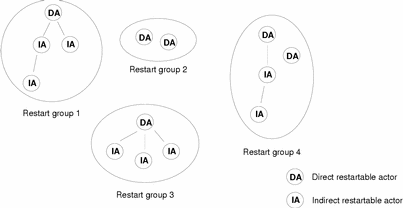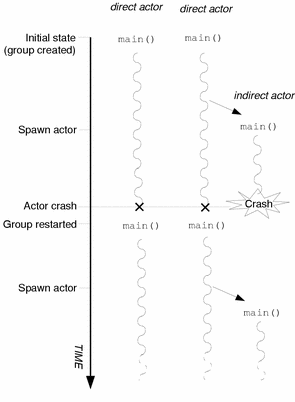Restart Groups
Many applications are made up of not one but several actors, that cooperate to provide a service. As these actors cooperate closely, a failure in one of them can have repercussions in the others. For example, assume that actors A and B cooperate closely, using the ChorusOS operating system over IPC, and that A fails. Simply terminating, reloading, or hot-restarting A will probably not be sufficient, and will almost certainly cause B to fail, or to go through some special recovery action. This recovery action may in turn affect other actors that cooperate with actor B. Building cooperating applications that can cope with the large number of potential fault scenarios is a complex task that grows exponentially with the number of actors.
In response to this problem, the hot restart feature uses restart groups. A restart group is essentially a group of cooperating restartable actors that can be restarted in the event of the failure or abnormal termination of one or more actors within the group. In other words, when one actor in the group fails, all actors in the group are stopped and then restarted (either directly, by the system, or indirectly, through spawning). In this way, closely cooperating actors are guaranteed a consistent, combined operating state.
Every restartable actor in a ChorusOS operating system is a member of a restart group. Restart groups of actors are mutually exclusive and, as such, a running actor can only be a member of one actor group (declared when the actor is run), and group containment is not permitted. A restart group is created dynamically when a direct actor is declared to be a member of the group. Thus, each group contains at least one direct actor. An indirect actor is always a member of the same group as the actor that spawned it. A restart group is therefore populated through spawning from one or more direct, restartable actors.
The following figure illustrates the possible organization of restartable actors into groups within a system.
Figure 3-3 Restart Groups in a ChorusOS Operating System

When a group is restarted, it is restarted from the point at which it initially started. Figure Figure 3-4 shows the state of a group of restartable actors when the group is initially created, during execution, and when it is restarted following the failure of one of its member actors. The group contains two direct actors and one indirect (spawned) actor. The failure of the indirect actor causes a group restart. The two direct actors automatically execute their code again from their initial entry point. Time runs vertically down the page.
Figure 3-4 Group restart

Note -
Simply restarting a group of actors may still not bring the system to the error-free state desired. Such a situation is possible when the failure that provokes an actor group restart is, in fact, the consequence of an error or failure elsewhere in the system. For this reason, the hot restart feature supports the concept of site restart, described in the next section.
- © 2010, Oracle Corporation and/or its affiliates
